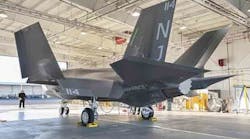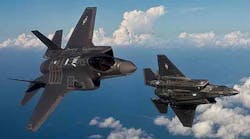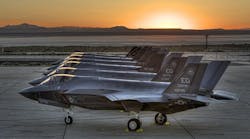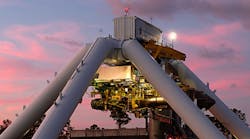Lockheed Martin, Pratt & Whitney, and numerous other manufacturers aligned in the F-35 Lightning II program met their 2014 production goals — 36 aircraft — delivering the last jet in the current series to the U.S. Marine Corps earlier this month. CF-19, as the jet has been designated, represented the first F-35C carrier variant delivered to the Marine Corps, which intends to use the aircraft for training.
The F-35 Lightning II is a single-engine fighter jet with stealth capability capable of ground attack, reconnaissance, and air-defense missions. The first series of jets are due for deployment late in 2015 by the U.S. Marine Corps, to be followed in subsequent years by versions for the U.S. Air Force, U.S. Navy, and the U.K. Royal Air Force. Nine other allied nations’ defense programs are involved in the development as future customers too.
Lockheed is the program’s prime contractor, performing final construction and overall system integration. Northrop Grumman provides the radar and other navigation, defense, and weapons control systems, among other critical systems. BAE Systems provides flight-control software, “electronic warfare” systems, crew life support and escape systems, and other systems. Pratt & Whitney manufacturers and supplies the F135 afterburning turbofan jet engine.
Earlier this year, Lockheed and the other major program partners for the F-35 Lightning II agreed to meet new, lower cost targets set by the U.S. Department of Defense for the jets.
DoD said the agreement would reduce the price of each F-35 to match its equivalent aircraft in today’s arsenal — notwithstanding the various technological advances to be included in the F-35.
The aircraft will be available in three design variants: the F-35A for conventional takeoff and landing; the F-35B for short takeoff and vertical landing; and the F-35C for carrier-based operations.
Of the 36 jets delivered in 2014, 23 were F-35A models delivered to the U.S. Air Force, four were F-35Bs delivered to the USMC, and seven were F-35Cs delivered to the U.S. Navy and USMC as joint recipients. Two more F-35A jets were delivered to the Royal Australian Air Force.
Since the F-35 Lightning II program’s inception, Lockheed Martin and its program partners have delivered 109 operational aircraft to the U.S. and allied nations.
"Meeting U.S. and International aircraft delivery goals is a stepping stone," stated Lt. Gen. Chris Bogdan, F-35 program executive officer. "It's a global undertaking to build and deliver F-35s. Thousands of men and women produced the 300,000 individual parts from 46 U.S. states and 10 other countries to make these stealth fighters, and they should be proud of their accomplishment."










